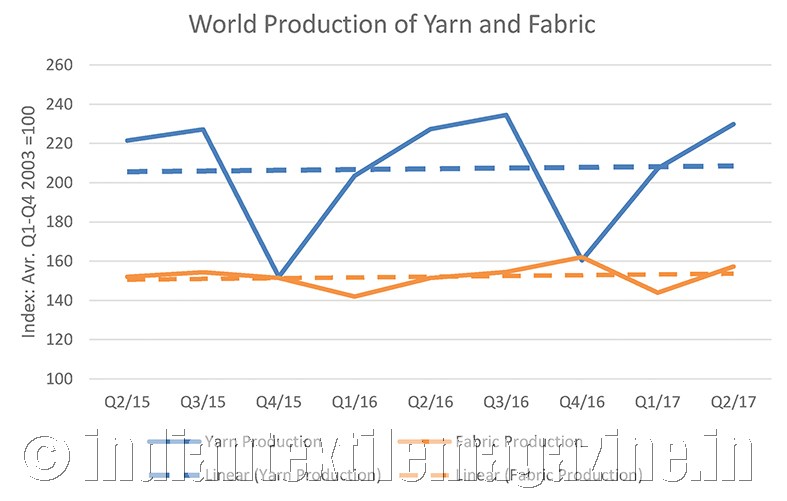Global yarn production declined by -0.4% between Q2/17 and Q3/17. An output reduction of respectively -3% and -0.5% in Europe and Asia have been balanced at the world level by increases of 0.5% in Africa, 4.8% in the US, and 6.5% in Brazil. Overall, the global level of yarn production in Q3/17 is slightly lower than it was in Q3/16 (-2.4%). This downward trend is expected to be observed in the fourth quarter due to negative forecasts in the Asian market.
Global yarn stocks decreased by -0.3% to -6% in all regions in Q3/17, but in Europe where stocks experienced a 10 percentage points increase. Altogether, yarn stocks reached 105% of the previous year level, a score which is about 10% below the Q3/15 results.
Global yarn orders fell by -2.7% around the world between Q2 and Q3/17, a compound effect of a 14% increase in Korea, European stability (100.3%) and decreases in Egypt (-2.5%) and Brazil (-11.7%). Global fabric production decreased from Q2 to Q3/17 by -0.6%. This reflects an improvement in Brazil (10.7%), stable conditions in the US (100%), and a reduction in Asia (-0.9%), Europe (-3.1%) and Africa (-7.6%). The world output level now reaches 101.7% of its Q3/15 level. Negative forecasts in all regions should lower this level in Q4/17.
In Q3/17, the global fabric stocks have shown a positive trend in all regions but in Egypt (-9%). In Q3/17, it reached 104.5% of the Q2/17 level. This improvement was nevertheless not sufficient to bring fabrics stocks at their Q3/15 level, which was 7% higher.
A significant positive change of 18.4% in stocks has been observed in Brazil. This trend has been setting in for the third consecutive quarter. While conditions are relatively stable in Asia and the US, Europe shows slow but constant positive changes.
Finally, the global fabric orders have improved between Q2 and Q3/17. A strong improvement in Brazil (18.3%) was compensated by reductions in Europe and Africa (-1.2% and -2.6% respectively), which brought the global index to 112.7% of its previous quarter level, very close to its Q3/15 level (-1.2%).
